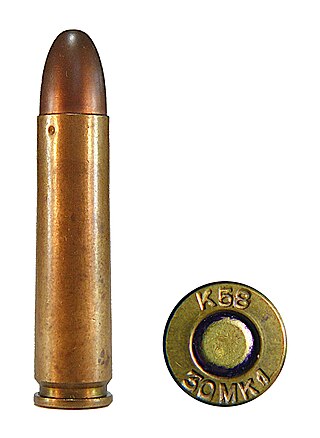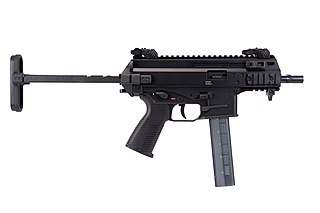Related Research Articles

A carbine is a long gun that has a barrel shortened from its original length. Most modern carbines are rifles that are compact versions of a longer rifle or are rifles chambered for less powerful cartridges.

The M1 carbine is a lightweight semi-automatic carbine that was a standard firearm for the U.S. military during World War II, the Korean War and the Vietnam War. The M1 carbine was produced in several variants and was widely used by paramilitary and police forces around the world, and also became a popular civilian firearm after World War II.

The M4 carbine is a 5.56×45mm NATO, gas-operated, magazine-fed carbine developed in the United States during the 1980s. It is a shortened version of the M16A2 assault rifle.

A breechloader is a firearm in which the user loads the ammunition via the rear (breech) end of its barrel, as opposed to a muzzleloader, which loads ammunition via the front (muzzle).

Personal defense weapons (PDWs) are a class of compact, magazine-fed, submachine gun-like firearms designed to fire rifle cartridges. Most PDWs fire a small-caliber, high-velocity centerfire bottleneck cartridge resembling a scaled-down intermediate rifle cartridge, essentially making them an "in-between" hybrid between a submachine gun and a carbine.

The Colt Automatic Rifle-15 or CAR-15 is a family of M16 rifle–based firearms marketed by Colt in the 1960s and early 1970s. However, the term "CAR-15" is most commonly associated with the Colt Commando ; these select-fire carbines have ultrashort 10.5-inch (270 mm) and 11.5-inch (290 mm) barrels with over-sized flash suppressors.

The .30 Carbine (7.62×33mm) is a rimless carbine/rifle cartridge used in the M1 carbine introduced in the 1940s. It is a light rifle round designed to be fired from the M1 carbine's 18-inch (458 mm) barrel.

The Bushmaster XM-15 series is a line of AR-15 style semi-automatic rifles and carbines manufactured by Bushmaster Firearms International, LLC. Variants include the Bushmaster M4-type Carbine, Patrolman series, QRC series, Bushmaster XM15-E2S, and the Carbon 15 line.

The Ruger PC-9 Pistol Caliber Carbine is a blowback centerfire semi-automatic pistol-caliber carbine manufactured by Sturm, Ruger & Co., designed as a companion to certain Ruger P series semi-automatic pistols, using the same 9 mm Parabellum and .40 S&W caliber cartridges and magazines of the P-Series pistols.

The Hyde-Inland M2 was a United States submachine gun design submitted for trials at Aberdeen Proving Ground in February 1941. Work was undertaken by General Motors Inland Manufacturing Division to develop workable prototypes of George Hyde's design patented in 1935. The model first submitted for trials in April 1942 was designated the Hyde-Inland 1. Trials revealed the design was superior to the M1 submachine gun in mud and dirt tests, and its accuracy in full-automatic firing was better than any other submachine gun tested at the time. An improved Hyde-Inland 2 was designated U.S. Submachine gun, Caliber .45, M2 as a substitute standard for the M1 Thompson in April 1942. As Inland's manufacturing capacity became focused on M1 carbine production, the US Army contracted M2 production to Marlin Firearms in July 1942. Marlin began production in May 1943. Marlin's production failed to match the trials prototype performance; and Marlin's original contract for 164,450 M2s was canceled in 1943 upon adoption of the M3 submachine gun. The M2 is chambered for the .45 ACP cartridge and used the same 20- or 30-round magazine as the Thompson. Its cyclic rate of fire is 570 rounds per minute. None of the approximately 400 manufactured were issued by any branches of the United States military.

The Moschetto Automatico Revelli-Beretta Mod. 1915 was a self-loading carbine that entered service in 1918 with the Italian armed forces. Designed as a semi-automatic rifle, the weapon came with an overhead inserted magazine, an unconventional design based on the simplicity of allowing a spent round to be replaced using assistance from gravity. The gun was made from half of a Villar-Perosa aircraft submachine gun.

Sharps rifles are a series of large-bore, single-shot, falling-block, breech-loading rifles, beginning with a design by Christian Sharps in 1848 and ceasing production in 1881. They were renowned for long-range accuracy. By 1874 the rifle was available in a variety of calibers, and it was one of the few designs to be successfully adapted to metallic cartridge use. The Sharps rifles became icons of the American Old West with their appearances in many Western-genre films and books. Perhaps as a result, several rifle companies offer reproductions of the Sharps rifle.

An assault rifle is a selective fire rifle that uses an intermediate cartridge and a detachable magazine. Assault rifles were first put into mass production and accepted into widespread service during World War II. The first assault rifle to see major usage was the German StG 44, a development of the earlier Mkb 42. While immediately after World War II, NATO countries were equipped with battle rifles, the development of the M16 rifle during the Vietnam War prompted the adoption of assault rifles by the rest of NATO. By the end of the 20th century, assault rifles had become the standard weapon in most of the world's armies, replacing full-powered rifles and sub-machine guns in most roles. The two most successful modern assault rifles are the AK-47 and the M16 designs and their derivatives.

The M1944 Hyde Carbine was an attempt by George Hyde to manufacture a light rifle for the US Armed Forces. The overall weapon was based on the Thompson Submachine Gun, which Hyde drew inspiration from in many of his weapon designs.

The Joint Venture Protective Carbine (JVPC), also known as Modern Sub Machine Carbine (MSMC) until 2014, is a gas-operated, magazine-fed, select fire submachine gun designed to chamber the 5.56×30mm MINSAS cartridge. It was designed by the Armament Research and Development Establishment of the Defence Research and Development Organisation, and manufactured by Advanced Weapons and Equipment India Limited. It was intended as a replacement for the 9mm Sterling submachine gun in service with the Indian Armed Forces.
George J. Hyde Sr. was a German-born American machinist, gunsmith and gun designer best known for his submachine guns. He was born in Apfingen, Germany. Already a skilled machinist, he immigrated to the United States in 1927. His family followed the next year.

The B&T APC is a family of firearms produced and manufactured by B&T of Switzerland. Announced in 2011, the submachine gun series uses standard 9×19mm (APC9), .40 S&W (APC40), 10mm Auto (APC10) and .45 ACP (APC45) ammunition.